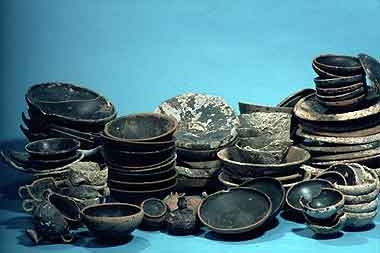- Home
- Gauls and Greeks
- Contacts with Greco-Roman cultures
- An Italian economic presence during the 2nd century BC
A shipwreck with amphorae from Madrague de Giens (around 70 BC).
The southern Gaul region was intensely implicated in the Punic Wars of the 3rd century BC and the expansion of Italic commerce in the western Mediterranean. This was due to the active support of Rome by Marseilles in conflicts and the opening of the regional market to Italic products.
The rise of Italic imports
During the 2nd century BC, several utilitarian objects, mostly kitchen and tableware, were added to the range of goods already imported in amphorae (wine, oil, brines). The quantity of black-glazed ceramics from Campania gradually increased during the 2nd century, reaching its in the very beginning of the 1st century BC.
Italic, black-glazed ceramics from the Grand Congloué shipwreck (around 190 BC).
Excavations at two important transit points, the ports and Arles, show that the monopoly of products from Marseilles (wine from the chora, and regional ceramics made from a light colored paste) was replaced with products from Italy. Distributors from the ancient Greek Naples region clearly dominated the market.
This phenomenon is clearly demonstrated at the Entremont settlement, which was founded during this period, by the absence of wine and a limited proportion of table ware from Marseilles.
Romanization before Romanization
Researchers have considered the role played by the indigenous coastal and Rhone region populations in these activities of exchange and distribution, in direct relation with the Italian negotiatores. Two elements illustrate the Roman presence in Gaul well before the military actions of 124-123 BC. These are the probable route between the Rhône and the Pyrenees of the future via Domitia during the 2nd century, and the recent discovery of a trading post in Lyon, established at the end of this same century.
Considering these factors, we can better understand the significance of the Italic influences seen in the urban and architectural evolution of populations near the Rhône after 150 BC. Glanon is an archaeological example that can be easily opposed with the traditionalism of Entremont, both in terms of its concentrated and archaic layout, and the nature of the architectural techniques that were employed.


